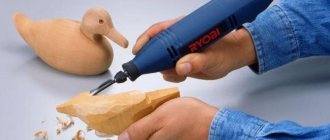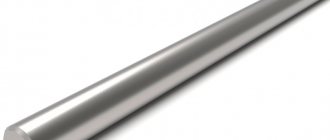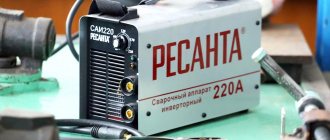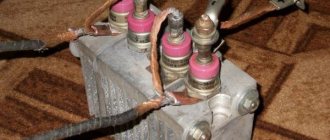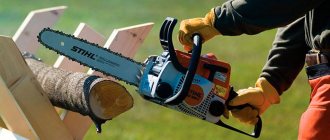The productivity of sawing work largely depends on the loss of working time, which is spent on replacing or sharpening the cutting elements of the standard set. A pobedite chainsaw chain does not have this drawback; however, professional sawers use such equipment in case of emergency.
Saw chains for chainsaws with pobedit tips are not in demand in amateur practice either, since the main advantages of the chain range with an increased service life do not compensate for its shortcomings.
Photo: victorious chain
Scope of application
A carbide chain is well suited, and sometimes simply irreplaceable, for sawing hard and super-hard wood. For example:
- bog oak;
- steamed wood, similar in density to bone;
- hardwood of the first cut (from a stump), butt, especially dry and twisted (with twisted fibers);
- dry wood with strong branches;
- wood with ice on the surface or contaminated with sand or soil.
Chainsaws with carbide chains are used for cutting ice for any need, including for creating ice sculptures.
Rescue teams from the Ministry of Emergency Situations routinely use only this type of cutting set, even when they have to clear debris made from ordinary wood. In extreme situations, there is no time to monitor the safety of the chain. Often the cutting edge touches stone, the ground, or metal gets into wood. A regular chain will instantly fail and require replacement, but during an emergency there is no time for this.
Advantages and disadvantages
The service life of a victorious chain is several times longer than the service life of a standard analogue. Modifications with carbide coatings do an excellent job of sawing hard and frozen wood. In emergency rescue operations, special headsets with pobedite chains are used for cutting concrete and metal reinforcement.
The benefits of such chains can be used to their full potential only on semi-professional or professional-class chainsaws, with engines that have sufficient power and torque reserves.
- A special chain for a chainsaw tipped with Pobedite or other material with similar characteristics provides a significant time gain when working with problematic wood, when preparing ice blocks and performing other labor-intensive and time-consuming work.
- The cutting links of the pobedit chain hold their edge stably when sawing dirty logs and are less sensitive to the abrasive properties of sand that gets into the cut.
User reviews confirm the feasibility and effectiveness of using carbide-tipped chains for sawing work of increased complexity.
Victory chain design
The pobedite chain consists of 3 types of links:
- cutting, a tooth is attached to them;
- leading, their lower part (fang) slides along the groove in the tire;
- figure-eight connecting plates.
These parts are connected to each other with rivets.
The cutting link, in addition to the tooth (cutter) itself, has a protrusion that limits the depth of cut.
That is, a pobedit chain does not differ from a regular one in any way, except for other qualities of the alloy of the cutting edge of the teeth.
How it works
The winner is a difficult-to-manufacture and expensive material. Therefore, not the entire tooth is made from it, but only the cutting edge. It is soldered to the body of the teeth using a copper alloy. Despite the softness of copper, such solders are quite strong and, as a rule, last their entire service life.
On pobedite chains, manufacturers do not use soldering, but make the entire cutting link from carbide.
Design Features
Pobedite chains perform better on more powerful than average chainsaws with high traction force. An ordinary tooth can be compared to a sharply sharpened blade. When it becomes dull, the sharpness can be easily restored by straightening the tooth with a special round file with a stencil for maintaining the angle. The pobedite tooth dulls slowly and imperceptibly. Even if slightly dull, it can still work well for a long time. But then more traction on the chainsaw is required, at least 3-3.5 hp.
What are the teeth made of?
A real winner is made using powder metallurgy technology and consists of 90% tungsten carbide and 10% cobalt with a small admixture of carbon. Tungsten and cobalt powder are pressed and then sintered at high temperatures close to melting the metal. Available in the form of plates, often already of a given shape.
The material was created in 1929, and since then, on its basis and according to its principle, many different materials have been created - VK4, VK6, VK8, VK10, T15K6, including those specifically for sawing wood.
How to choose
The selection issue is relevant for inexperienced users. Professionals know almost everything about the headset and know how to choose what they need. For this reason, our advice will be aimed specifically at amateurs, and not at pros. So let's get started.
In order to choose correctly you need:
- Know the characteristics of the chainsaw, namely the pitch and length of the bar. When choosing, you should not rely on the name and model of the chainsaw, because... One chainsaw can be equipped with tires of different lengths and seat widths.
- Decide in advance on the volume and type of work for which you plan to use it. If you cut across, we choose chisel ones; if we cut along, we choose chipper ones.
Important! You will have to sharpen it for a longitudinal cut (10) yourself or at a service center. A headset sharpened for longitudinal cuts is rarely found on sale
Separately, it is necessary to mention the choice of the Shtil headset. If you are planning to buy a chain from this manufacturer (they are considered the highest quality today), then to make your choice it is better to use a special search form, which can be found on the company’s website.
By entering the chainsaw data into the search form, the program will automatically select and offer you suitable options. The service is convenient, but has one big drawback: selection is carried out only according to Shtil chainsaw models. In order to select a chain for saws of other brands, you will have to arm yourself with a catalog.
Overview of circuits with pobeditovy soldering
Unlike saw blades, until now, chains with pobedit tips have not become widespread. Neither for domestic use nor in the logging industry. Even powerful chains for harvesters - forestry machines, from fellers to loppers - most often do not have pobedit inserts.
It is important that you should not confuse wood chains with chains for gas cutters for other purposes. For example, today there are diamond-coated chains on sale that are structurally, in size and externally similar to wood chains. They are designed for cutting brick, concrete and even metal. But they are not suitable for chainsaws in terms of pitch, thickness and length, and cannot cut wood. The wood simply smokes and burns from friction, as if drilled with a Pobedit drill.
How to extend the period from sharpening to sharpening a chainsaw
Maybe now we will utter common truths, but some people neglect them, apparently in the hope that everything will work out without it, according to the phrase of the hero of the famous cartoon “Vovka in the Thirtieth Kingdom” - “Ah, and so it will do...”. Under no circumstances should you cut with a saw if there are foreign objects in the wood or board, first of all, nails that have not been removed, or a metal strip. Once you “drive” over a normal nail, you will, of course, even saw it through, but after that, take a look at the cutting edges of the chainsaw chain, because sometimes this is an irreparable defect, with chips and plastic deformation of the teeth. In such cases, a hand chain sharpening tool may not always help. Before starting work, check the saw area for the absence of any foreign objects; the wood must be clean, preferably dry, although this will depend on how it turns out. You should not cut on the ground without placing something under the cut. In this case, after cutting you will have to go deeper into the ground, and this is oh, how undesirable for your chain. Earth, sand, stones, all this can also quickly and irrevocably damage the chain of your chainsaw, forcing you to start sharpening it after one or two uses of the new chain. Make sure that the saw does not “bite” while cutting, so as not to overheat the metal and the blade of the saw. Monitor the chain lubrication and the oil level in the tank. As a result, as you understand, the chainsaw, which seems to be such an “invincible” hand tool, itself needs protection if you want accurate, timely and efficient work from it.
Which winning chain to choose for your home
However, recently new chains with carbide cutters have appeared on sale, which we have always called and will continue to call Pobedit. Moreover, specifically for household and semi-professional chainsaws. These are Rapid Duro 3 chains, manufactured by STIHL in Switzerland. The chains are without soldering, the entire cutting link is entirely made of hard alloy.
Specifically, these are the chains:
- STIHL 63PD-56E 16 inches long, 1.3 mm thick.
- STIHL 63PD-50E 14 inches long, 1.3 mm thick.
- STIHL Picco Duro 3/8-1.3-57 is the world's first carbide version of a low-profile chain.
Despite the fact that these chains have appeared quite recently, there is already experience in their use. These chains today cost 4-5 times more expensive than regular ones, from 1600 to 2000 rubles. According to reviews, they last about the same number of times longer than usual without sharpening.
For information on the rules for selecting a carbide (pobedite) chain for a specific chainsaw, see the following video:
Reviews
Need forced me to buy carbide. The willow tree trunks have been lying around for about five years. Dry as a bone. It is impossible to cut anything. They don’t use hand saws; the chain on a chainsaw smokes. And the firewood is first-class for the bathhouse. Yes, and it’s a matter of principle. I bought a Shtilev chain. Well, I think, if I ruin the chain, and it’s not cheap, I’ll burn all this broom in a fire in the garden. But he sawed it. The sawdust was small, but it was easy to saw. I felt it with my finger - sharp teeth. I examined it with a magnifying glass - it was not curled up or blunted anywhere. That’s why I’m sure it will serve you unless I foolishly hit you with a stone or something else.
Sergey, Lipetsk.
They forced it on me along with a chainsaw in a store. New, no demolition. And I just had to saw mountains. Over the summer I put it on the throwaway. The teeth are alive. I adjusted it once with a diamond round file. And the chain itself stretched as usual. The adjustment was no longer enough to tighten, so I knocked out the bushing and shortened it by two links. I worked some more and it’s stretching again. And then it can no longer work, it will either not get on the sprocket teeth, or it will erase them, and the sprocket will have to be changed. The result is that I’d rather have 4 usual chains for the same money.
Valera, Tambov.
As a result, carbide chains, also known as pobedite chains, do not save users money. They can last two to three times longer before they stretch, but cost four times more. But they will find their use. Because they cut what other chains simply cannot. And they rarely require sharpening, and with a small amount of work this can be only once a year, or even twice.
Pobedite chain for professional work
For professional chainsaws, manufacturers still offer chains with old alloys, which are commonly called “quick cutters”. Knives for planes are made from similar alloys, and old circular saws were made without carbide tips.
The new carbide chains from STIHL listed above are 1.3mm thick, which is the same as for household and semi-professional chainsaws. The production of such chains with a thickness of 1.5 mm and higher for powerful chainsaws has not yet begun.
However, high-speed alloys have different compositions and qualities. And for professional chains, they are stronger and more durable by default. As a rule, it is enough to have a replacement set of 2-3 spare sharpened chains and a file for straightening, and no special problems arise even with large volumes of work.
Features of use
In order for the chain to serve as long as possible, it is important to follow some rules when using it:
- When processing reclaimed or problematic wood, you need to move the saw to the intended location much more slowly than when working with a conventional tool.
- The feed rate into the cut can be increased as the saw heats up.
- It cannot be lubricated with products containing sulfur - it reacts with cobalt, which is found in any carbide chain.
Expert opinion
Kuznetsov Vasily Stepanovich
If it is obvious that you have to work with wood of different hardness, it is better to use an old blade for processing it, which you don’t mind throwing away - sudden hard areas can crumble.
The connecting links of a carbide chain are made of ordinary steel, so it can wear out much earlier than the teeth become dull. The most common problem is chain stretching. Riveting and removing a couple of links will help to temporarily return the canvas to working condition.
It must be taken into account that using a shortened chain leads to rapid wear of the sprocket, increasing the risk of chain breakage and loss of smooth running.
Refurbishment of carbide chains
Early adopters of carbide chains found that they dulled over time, although at a much slower rate.
Then the problem arises - how to sharpen a hard alloy that a conventional file cannot handle. An ordinary sharpening disc on a special machine will not sharpen it either, so today not every service center can sharpen such a chain. And if they can, then it is expensive.
Therefore, along with the purchase of such a chain, it is better to immediately buy a diamond blade for sharpening. A diamond-coated aluminum disc with a thickness of about 10 mm is suitable for a conventional electric sharpener.
You can also sharpen carbide alloys with a diamond disc on a regular angle grinder (grinder) using homemade fasteners and guides.
Owner reviews
When purchasing a powerful chainsaw, they gave a decent auction discount. To celebrate, I purchased a “long-lasting” Shtilevsky chain with carbide teeth at a substantial additional cost, which I installed when I arrived home instead of the standard one. Indeed, the headset produced small shavings only after a month and a half of fairly intensive use. I can’t sharpen the cutting edges myself; I can’t handle a file. Taking it to a service center is far away and expensive; it’s cheaper to buy a new chain. I will try not to make such mistakes in the future. Fedor Timofeevich
I have negative experience in using DURO 36RD carbide chain. The chain purchased at the company store conscientiously worked out its life on bucking raw frozen wood. The headset more than once picked up dirt and sand from the surface of the logs without any particular consequences, but somehow everything worked out. The second chain of the same brand, ordered from an online store, turned out to be a successfully made fake, since during operation the cutting edges of the saw links do not crumble, but become jammed. The alloy, indistinguishable to the eye, is significantly inferior to real Pobedit in terms of wear resistance. The only consolation is that I was able to sharpen the teeth using a diamond disc. Denis
What determines the productivity of sawing work? Many focus on the time spent on servicing the saw replacement set. Maintenance may consist of re-sharpening an unevenly worn chain, as well as replacing some cutting elements to avoid loss of standard settings and parameters. You can forget about such problems by using a winning chain. Pobedite Stihl chains, like many produced by other companies, are quite popular due to a number of characteristics, however, they are not used on an ongoing basis, but as a last resort.
How to find out what type of headset is on a chainsaw
There are several ways to determine the type of chain that is installed on a chainsaw. If the saw is new, just purchased, then the type and size of the chain are indicated in the documents (user manual, in the characteristics section). If the saw has already had time to work and it is not known whether the headset has changed during operation, then you can determine the type of chain by performing the following steps:
- Remove the headset and count the number of links.
- Using a caliper, measure the width of the shank.
- Visually determine the type of cutting tooth. Sharp side edges are chisel, smooth edges are chipper.
- Use a ruler or caliper to measure the chain pitch.
Important! Incorrectly taken dimensions can lead to the fact that the new chain will not fit into the chainsaw bar or will have a pitch different from the pitch of the sprockets, so you need to be more careful when taking measurements. Another option to determine dimensions, which does not require the use of a measuring tool, is to look at the markings
The width of the shank is indicated on the outside of the stop tooth. The width values on the tooth are shown without a unit, i.e. if there is a number 3 on the tooth, then the width of the shank is 1.3 mm, other dimensions are the same
Another option for determining dimensions that does not require the use of a measuring tool is to look at the markings. The width of the shank is indicated on the outside of the stop tooth. The width values on the tooth are shown without a unit, i.e. if there is a number 3 on the tooth, then the width of the shank is 1.3 mm, the other dimensions are the same.
Some manufacturers, such as Oregon, put the model number on the shank of their products. Knowing the number, you can easily determine the characteristics of the chain by finding information about the model in the catalog.
Step-by-step installation algorithm
Not all modern chainsaws are equipped with an installation wheel, which significantly simplifies the procedure for installing the saw blade. Systems with an adjustment wheel are generally rare among household chainsaws.
Therefore, it is very important to know the technology and sequence of installing a chain on a chainsaw
Key points to note:
- Prepare a flat surface on which you will assemble the chain and bar. This will minimize the chance of damage to the chainsaw or loss of small parts. A tire is laid out on the prepared surface and a chain next to it in parallel.
- Remove the sprocket guard, on modern chainsaws it is enough to unscrew the wing nut, on older models you may need a spanner of the appropriate size.
- At the base of the guide bar, turn the tension sprocket all the way to the right. Only in this position is the chain installed.
- Then the chain is placed sequentially, link by link, onto the locking groove on the guide bar. Install the chain from the top of the guide, gradually turn it so that the bar is always on top and the chain is on the bottom, this will allow it to always be taut and fit into the guide groove without problems. When performing this step, be sure to wear thick protective gloves, because your fingers will touch the cutting edge. If you look from above, the cutter is always located forward towards the end of the guide bar.
- Place both the bar and chain on the drive sprocket.
- Secure the chain sprocket cover in place. Make sure all mounting pins line up with the holes. Incorrect installation with distortions or not completely can cause extraneous noise and rattling.
- Make sure that the guides fit into the special mounting groove.
- After installation, check that the chain is secure on the chainsaw and on the bar. Everything should be securely fastened without any backlash.
An important point is the degree of chain tension after installation. Setting the correct tension is very simple and takes no more than three minutes. First you need to loosen the nuts on the protective cover. Using a freely rotating adjusting screw, set the correct tension so that the chain does not pull more than 3-5 mm from the edge of the guide bar.
All that remains is to tighten the nuts and check the tension. If adjustment is necessary, adjust the tension again.
How to install a bar and chain on a chainsaw, see the following video, which presents a clear algorithm of actions:
Ways to check the degree of tension
Checking the tension level is important, as the consequences of incorrect adjustment can be fatal for the sawyer. The quality of chain tension adjustment can be determined by:
- When moving the product manually, it should not jam or show signs of difficulty in its movement.
- The cutting element must be checked for looseness by grasping the link and trying to pull it up. The normal tension value should correspond to the exit of the shanks from the tire (in its middle) of no more than 2/3.
- When moving the device, there should be no creaks or other extraneous noise.
In conclusion, it should be noted that you should never adjust the chain while it is hot, as this will certainly lead to a number of negative consequences. As a result of such actions, it may be necessary to replace not only the tire and chain, but also the drive sprocket.
What does it consist of?
A modern saw chain is made of three types of links:
Working teeth are divided into left-handed and right-handed. The leading ones, also called shanks, are installed between the connecting and working ones with a certain pitch, which depends on the size of the links. Connecting, as the name implies, combines working and driving links.
There are two main types that can now be found on sale: chipper and chizzle chains. The division is based on individual parameters and the shape of the working tooth.
Chipper ones are more universal.
They can be used by both ordinary users for work at home, and by professionals for longitudinal sawing. Most often, professionals use saw chains of this type on chainsaws operating in LOGOSOL type sawmills
They, subject to the required sharpening angle (10 0 ), are able to quickly saw along the fibers, which is the most important thing in a sawmill, while their performance and high productivity are maintained for a long time. If necessary, chains of this type, like others, can be sharpened using a file or sharpening machine.
Chisel - show greater productivity when cutting crosswise.
Used by professionals for felling and bucking. The angles of attack of such a chain are aggressive, it cuts easily and cuts quickly, but only across the grain. The cutting speed along the length, even with proper sharpening, is lower for such a headset.
Below is a video about the types of chains and selection criteria for a chainsaw. It describes in detail the main parameters of the headset. Shows what different types and sizes of links look like
Much attention is paid to pitch and width
Special
A separate type of chains for chainsaws are carbide, special purpose. These include chains for cutting concrete, aerated concrete or emergency rescue work. The design of the tooth in such a set includes pobedite soldering, which allows you to saw concrete, thin metal, reinforcement, and glass.
Such chains are very expensive. It is not advisable for the average user to buy them.
Measuring the degree of sharpening of a circular saw
As a rule, circular saws with pobedite tips are used occasionally, but for significant volumes of material over a long period of time. Therefore, it is completely normal that the incisors begin to wear down over time. This product needs to be sharpened if necessary. Finding the degree of sharpening is quite easy:
- When sawing the material, bulges, nicks, and chips begin to appear, and when cutting wooden objects, a corresponding smell and dark marks on the material begin to appear;
- Working on the machine becomes more complicated because you need to exert more than just effort, and as a result there is a powerful load on the engine.
Fundamentally! Failure to monitor the sharpness of the disc cutters leads to the fact that the product cannot simply be sharpened or repaired. Therefore, it is worth painstakingly taking care of the condition of the instrument.
It must be said that these machines are equipped with protective relays. If there are none, the device may malfunction more quickly if the sharpening is incorrect or inappropriately made.
Main settings
Saw chains are usually distinguished by:
- cutting direction (longitudinal and transverse);
- dimensions (length and size of the elements of the chain set);
- design features;
- the order of the cutting links.
Cutting wood along the grain causes more resistance than cutting across it. Due to the demand for both types of sawing, two types of saw chains are produced - longitudinal and transverse. They differ in the angle of attack of the incisors. As a result, when cutting longitudinally, the productivity of the saw increases, and when cutting transversely, the “aggressiveness” of the tool is smoothed out. Well, together with the latter, it reduces the level of vibrations and reduces the load on the engine.
Chainsaw tires on the market today have different dimensions. One of the main parameters of the saw chain is the number of links, i.e. chain length. In addition, chain systems have a certain pitch. It is measured by the distance between three links connected in series, divided by two.
There are 3 main parameters of a chainsaw chain:
- Chain pitch
- Number of links
- Drive link thickness
Chain pitch
equal to half the distance between three adjacent rivets. Consequently, the distance between the cutting skates directly depends on the step. It can be larger or smaller, depending on 5 standard groups measured in inches: “1/4”, “0.325”, “3/8”, “0.404” and “3/4” (chronology in order of increasing length) .
“1/4”—this fine pitch is found on short chains installed on low-power saws and one-handed versions. You can hardly find such saws in Russia, and this size is not particularly popular or in demand on the market.
“0.325” and “3/8”—the majority of saws are equipped with these chain pitch sizes. All well-known manufacturers of chainsaws and electric saws install these popular groups. With a high degree of probability, when selecting a chain, you will need to choose one of these options.
“0.404” and “3/4” are chains with large and long links and are now practically not used. The exception is powerful felling models of saws. Also, this step is standard on old, long-out-of-production, domestic saws Ural and Druzhba.
The pitch of the chain must match the pitch of the drive sprocket. It is impossible to say for sure which step is better, it all depends on the specific process. As the pitch increases, the links that make up the chain will be larger, and this increases productivity. At the same time, the resistance of the material and vibration will increase, since the “gnawing” of the chain will be more aggressive. Keep in mind that this will require a more powerful saw. A fine pitch gives a clean cut, while the frequent arrangement of teeth ensures smooth movement of the headset in the wood. Less vibration.
Number of links
includes the total number of connecting links and cutting, alternating right-handed and left-handed teeth. The entire structure is held together by leading links (more on them later in the article) and rivets. In fact, this is the entire component of the saw chain.
The number of links is replete with variety and it is difficult to single out something more popular. Moreover, the same saw model can be supplied from the factory with different sets of chains and bars. If for some reason all the inscriptions by which you can determine the required number of links on the saw and bar have been erased, the instructions have been lost, etc., then the easiest way to determine is to count manually.
Leading links
These are a kind of constructive transfer hooks on the chain. They should move freely, but at the same time steadily, from the drive sprocket (the saw motor gives it rotation) along the groove of the bar. The thickness of the groove of the bar and the drive link must match perfectly. Due to this, a stable state of the structure is achieved and, with proper tension, jumping is prevented even at high speeds.
It is worth noting that the drive link plays the role of an oil distributor along the entire edge of the chain and bar. The oil pump is connected to the drive sprocket and then the links pump out the necessary lubricant during the rotation process. The international classification is based on 5 standard sizes of drive link thickness:
1.1 mm (0.043 in) - not as common on low-power saws or single-handed saws.
1.3 mm (0.050 inches) and 1.5 mm (0.0578 inches) are the most common sizes, installed on household and semi-professional saw models.
1.6 mm (0.063) and 2.0 mm (0.080 in) thick drive links are found on high power professional saws.
The chain pitch, drive link thickness and number of links, together with the drive sprocket and saw bar, must be mutually applicable and form a single “composition”. Knowing all three of these standard sizes, you can easily select the right chain.
Upper part of the shank
Its design affects safety. Professionals are highly experienced, they follow all safety regulations, and productivity is extremely important in their work. Therefore, the design of a “professional” chain usually does not have an upward extension of the shank, which ensures fast and aggressive sawing (for example, the Husqvarna X-Cut C85 chain). The average user does not have such experience. In order not to create the effect of instantaneous rebound, especially when the rotating chain touches the wood with the nose of the tire, the upper part of the shank is made in the form of a “springboard”. This greatly minimizes bounce. This parameter is encrypted in the designation of new Husqvarna chains as the symbol “G” (in Husqvarna X-Cut SP21G, S93G, SP33G saw chains).
Dimensions
To understand how a chain works, you need to know its pitch. It is measured available:
- 0.325 in;
- 0.375 in;
- 0.404 in.
The steps are predetermined by the corresponding consumers and tools.
Each type of chain is selected for certain jobs and with its own torque. Smaller steps equal greater productivity. A minimum of link connections widens the cut and adds muscular effort.

